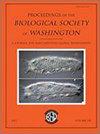Costapex baldwinae, a new species of bathyal costellariid (Mollusca: Gastropoda: Neogastropoda: Costellariidae) from the Caribbean Sea
IF 0.5
4区 生物学
Q3 Agricultural and Biological Sciences
引用次数: 0
Abstract
Abstract. Costapex baldwinae, new species, is described from deep reef habitats of the southern and eastern Caribbean Sea, including Curaçao, Dominica and Guadeloupe, where it occurs at bathyal depths on sunken wood. It is assigned to the genus Costapex based on phylogenetic analyses using partial sequences of COI, 12S and 16S mitochondrial genes that reveal it to be the sister species of two Indo-Pacific members of this genus. This new species most closely resembles Costapex martinorum (Cernohorsky, 1986) from the Philippines, but differs in being smaller, and in having a slightly lower spire and more prominently beaded spiral sculpture. Of the Caribbean species of costellariids, it is somewhat similar to Nodicostellaria laterculata (Sowerby II, 1874), which occurs in shallower water and has a white or tan rather than dark brown shell, and also a taller spire, more prominent axial sculpture, and a more rounded aperture. It differs from Vexillum styria (Dall, 1889), with which it co-occurs, in having a broader shell with a lower spire, prosocline rather than opisthocline axial ribs, and more prominent, strongly beaded spiral cords. Costapex baldwinae differs from both these taxa in having rachidian teeth with three cusps rather than five cusps (N. laterculata) or seven cusps (V. styria). The genus Costapex was previously known only from Indo-Pacific species. The discovery of this new species represents a significant expansion of the range of this genus into the Caribbean Sea.Costapex baldwinae,一种来自加勒比海的半深海costellariid(软体动物:腹足纲:新腹足目:Costellariidae)的新种
摘要Costapex baldwinae是一种新物种,来自加勒比海南部和东部的深礁栖息地,包括库拉索岛、多米尼克岛和瓜德罗普岛,在那里,它出现在沉没的木材上的半深海。根据COI、12S和16S线粒体基因的部分序列进行的系统发育分析,将其归入Costapex属,这表明它是该属两个印度-太平洋成员的姐妹物种。这一新物种与菲律宾的Costapex martinorum(Cernohorsky,1986)最为相似,但不同之处在于体型较小,尖顶略低,螺旋雕塑上的串珠更为突出。在加勒比物种中,它有点类似于Nodicostellaria laterculata(Sowerby II,1874),它出现在浅水中,外壳为白色或棕褐色,而不是深棕色,还有更高的尖顶、更突出的轴向雕塑和更圆的光圈。它不同于与它共同存在的styria(Dall,1889),因为它有一个更宽的外壳,有一个较低的尖顶,前斜而不是前斜轴向肋,以及更突出的、强烈珠状的螺旋索。Costapex baldwinae与这两个分类群的不同之处在于,它的轴状牙齿有三个尖,而不是五个尖(N.laterculata)或七个尖(V.styria)。Costapex属以前只在印度-太平洋物种中发现。这一新物种的发现标志着该属在加勒比海的范围显著扩大。
本文章由计算机程序翻译,如有差异,请以英文原文为准。
求助全文
约1分钟内获得全文
求助全文
来源期刊
自引率
0.00%
发文量
0
审稿时长
>12 weeks
期刊介绍:
The official publication of the Biological Society of Washington, the Proceedings of the Biological Society of Washington is an international journal containing peer-reviewed papers that broadly bear on systematics in the biological sciences (botany and zoology), paleontology, and notices of business transacted at Society meetings.

 求助内容:
求助内容: 应助结果提醒方式:
应助结果提醒方式:


